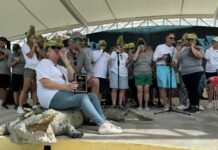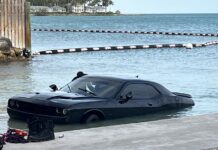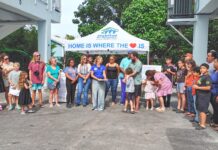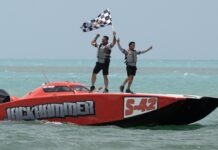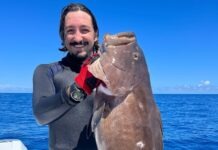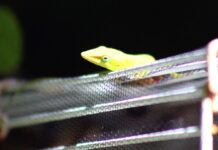
By John Christopher Fine
Unless a space landing is spectacular, routine launching of rockets and satellites go unnoticed in a world beset by terrestrial mayhem that captures headlines.
When Nazi Germany launched warhead-loaded rockets at Britain toward the end of World War II, fear and devastation followed. A world woke up to a new weapon of war that condemned innocent people to death. With Germany’s surrender, allies scrambled to capture scientists involved with rocket programs. It was war, not science, that impelled discovery, just as it was enmity that propelled rivalry in the conquest of space.
“Aquanauts to Astronauts” is the current theme of an extraordinary exhibit at the History of Diving Museum (HDM) in Islamorada. Photographs, mementos and actual items from the grand era of space exploration are displayed in a dedicated area that recounts the history of space exploration and its nexus to underwater training of space candidates to weightlessness.
In 1947 the U.S. launched drosophila – fruit flies – in a rocket. This was an attempt to determine whether living organisms could live and withstand radiation in space. The fruit flies survived without the effects of radiation. This experiment was followed two years later with the launching of a Rhesus Macaque monkey, dubbed Albert II, 83 miles into space. The monkey survived in space, but died on impact when the craft landed. A previous attempt failed when the monkey suffocated even before launch. These tests were preparatory to launching humans into space.
Aquatic habitats are modeled in HDM’s exhibit as well as diagrams and photographs of divers and aquanauts training underwater. It is uncanny to witness progress from rocket launches to moon walks and exploration. It is also reminiscent of the Cold War as the United States and the Soviet Union raced to be the first in space. The race was won by Russian Cosmonaut Yuri Gagarin on April 12, 1961 with his dramatic remark “Poyekhali” – “Let’s go” – from Vostok 1. Not far behind, the U.S. launched the first American in space, Alan Shepard Jr., on May 5, 1961, in Project Mercury.
Apparel in space is critical, just as deep ocean diving requires special suits and dress. HDM’s permanent exhibit consists of deep sea diving helmets, dress and apparatus along with deep water one atmosphere suits that resemble astronaut space suits. Extra Vehicular Activity (EVA) suits had to be prepared to protect spacewalkers from debris that could hit and tear them.
Exposure in direct sun in space raises temperatures to 250 degrees Fahrenheit. On the shaded side, temperatures are minus 250. EVAs had to be tethered, and they also had mini-jet packs, not unlike various diver propulsion devices underwater and lines in certain cases to ensure safety. The huge difference is that spacewalkers are working in orbit at a speed of 5 miles per second. HDM’s exhibit creators considered this would be equivalent to driving between Boston and Philadelphia in one minute.
The exhibit includes a jumpsuit worn by U.S. astronaut Kathy D. Sullivan. Not only was she the first woman to spacewalk, Sullivan was the first woman to reach the deepest ocean in the Marianas Trench. The first woman in space illustrated in photographs is Russian Cosmonaut Valentina Tereshkova, who traveled in space in 1963 for 71 hours in 48 orbits aboard Vostok 6. Tereshkova then piloted her spacecraft back into the Earth’s atmosphere and parachuted to the ground.
A fascinating exhibit of NASA’s MK 16 rebreather and SuperLite 17 helmet is on display. The suit and helmet were used by NASA’s Neutral Buoyancy Lab underwater as training for astronauts. The unit resembles modern rebreathers in use by divers today. Scuba divers would accompany astronauts underwater in the pool guiding them and providing safety.
Visit History of Diving Museum’s latest exhibit any day between 10 a.m. and 5 p.m. The museum is located at MM 83 in Islamorada.
